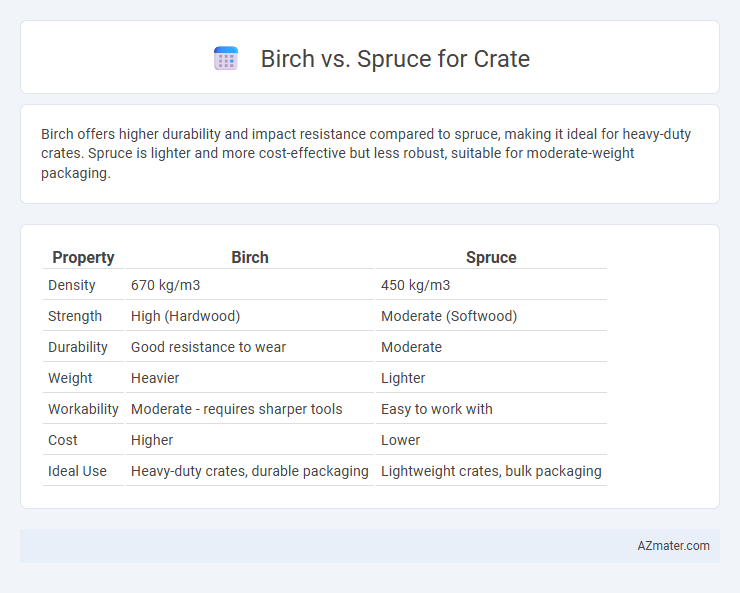Birch offers higher durability and impact resistance compared to spruce, making it ideal for heavy-duty crates. Spruce is lighter and more cost-effective but less robust, suitable for moderate-weight packaging.
Table of Comparison
| Property | Birch | Spruce |
|---|---|---|
| Density | 670 kg/m3 | 450 kg/m3 |
| Strength | High (Hardwood) | Moderate (Softwood) |
| Durability | Good resistance to wear | Moderate |
| Weight | Heavier | Lighter |
| Workability | Moderate - requires sharper tools | Easy to work with |
| Cost | Higher | Lower |
| Ideal Use | Heavy-duty crates, durable packaging | Lightweight crates, bulk packaging |
Introduction to Birch and Spruce as Crate Materials
Birch and spruce are popular wood choices for crate construction due to their distinct properties and availability. Birch is a hardwood known for its strength, smooth texture, and resistance to wear, making it ideal for crates requiring durability and a polished finish. Spruce, a softwood, offers lightweight characteristics and good flexibility, suitable for crates designed for easier handling and moderate protection needs.
Wood Characteristics: Birch vs Spruce
Birch wood is dense, durable, and features a fine grain with a smooth texture, making it ideal for sturdy crates that require strength and resistance to impact. Spruce, on the other hand, is lighter and less dense, with a straight grain and a softer texture, providing easier workability but less durability under heavy loads. For crates needing robustness and resistance to wear, birch outperforms spruce in maintaining structural integrity over time.
Strength and Durability Comparison
Birch offers superior strength and durability compared to spruce, making it ideal for crates requiring heavy load-bearing capacity. The dense grain structure of birch provides enhanced resistance to impact and wear, extending the lifespan of crates under rigorous use. Spruce, while lighter and more flexible, tends to be less durable and more prone to dents and damage in high-stress applications.
Weight Differences in Crate Applications
Birch is significantly denser than spruce, resulting in heavier crates that offer greater durability and load-bearing capacity. Spruce's lighter weight makes it ideal for crates intended for easier handling and transportation, especially when weight restrictions apply. Choosing between birch and spruce depends on balancing the need for strength versus the requirement for reduced shipping weight in crate applications.
Cost Analysis: Birch vs Spruce Crates
Birch crates typically incur higher costs due to the wood's dense grain and durability, making them ideal for heavy-duty shipping and long-term storage. Spruce crates are more budget-friendly, offering lightweight strength suitable for short-term use or lighter goods, reducing overall material and shipping expenses. Choosing between birch and spruce crates depends on balancing cost efficiency with the required durability and end-use application.
Workability and Ease of Construction
Birch offers excellent workability due to its fine, even grain, making it easier to cut, sand, and shape for crate construction. Spruce, while softer and lighter, tends to have a coarser grain which can lead to splintering and requires more careful handling during assembly. Overall, birch provides smoother finishes and greater precision, whereas spruce may need extra care but is valued for lightweight applications.
Environmental Impact and Sustainability
Birch wood, sourced from fast-growing deciduous trees, generally has a lower environmental impact than spruce due to its higher carbon sequestration rate and shorter growth cycle. Spruce, commonly found in boreal forests, benefits from widespread availability but can contribute to habitat disruption if not harvested sustainably. Opting for FSC-certified birch or spruce ensures sustainable forestry practices, preserving biodiversity and minimizing ecosystem degradation in crate production.
Moisture Resistance and Longevity
Birch exhibits higher moisture resistance compared to spruce, making it a preferred choice for crates exposed to humid or damp environments. The dense grain structure of birch enhances its durability and longevity, ensuring the crate withstands prolonged use without warping or degradation. Spruce, while lighter and more affordable, absorbs moisture more readily, leading to reduced lifespan and potential structural weakness over time.
Aesthetic Appeal and Finish Options
Birch offers a smooth, fine grain with a pale color that provides a clean and modern aesthetic, ideal for crates requiring a sleek, uniform finish. Spruce features a more prominent grain with a warm, yellowish tone, lending a rustic and natural look preferred for crates emphasizing organic texture. Both woods accept stains and finishes well, but birch's consistent grain allows for a more even and polished finish, while spruce's texture highlights natural imperfections that enhance its visual character.
Choosing the Right Wood for Your Crate Needs
Birch offers exceptional strength and a fine, smooth grain that enhances durability and aesthetic appeal, making it ideal for crates requiring a polished finish and structural integrity. Spruce is lighter and more affordable with good flexibility, suitable for crates needing cost-effectiveness and lighter weight without sacrificing moderate strength. Selecting between birch and spruce depends on prioritizing factors such as load capacity, budget constraints, and desired appearance for your crate application.

Infographic: Birch vs Spruce for Crate
 azmater.com
azmater.com